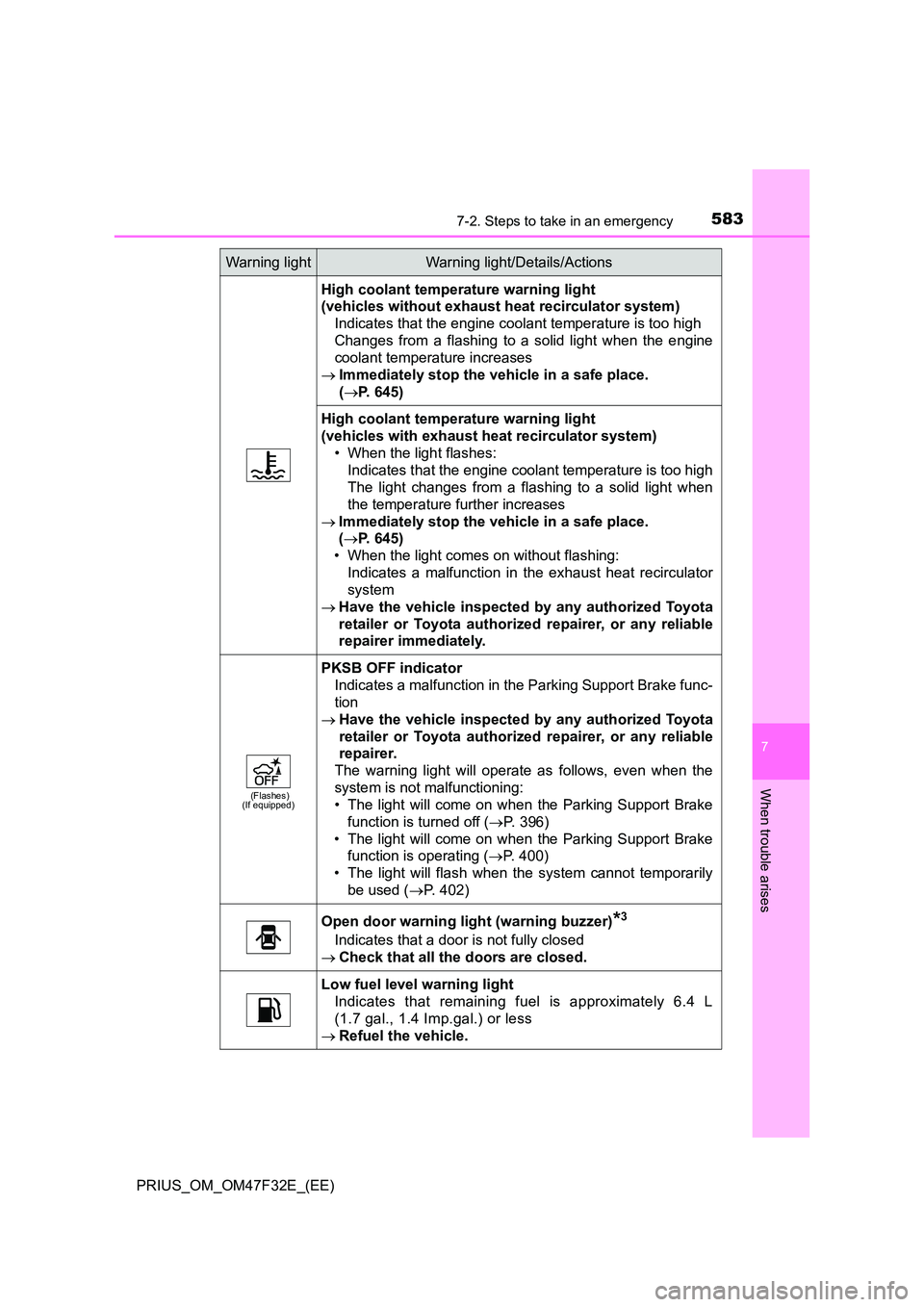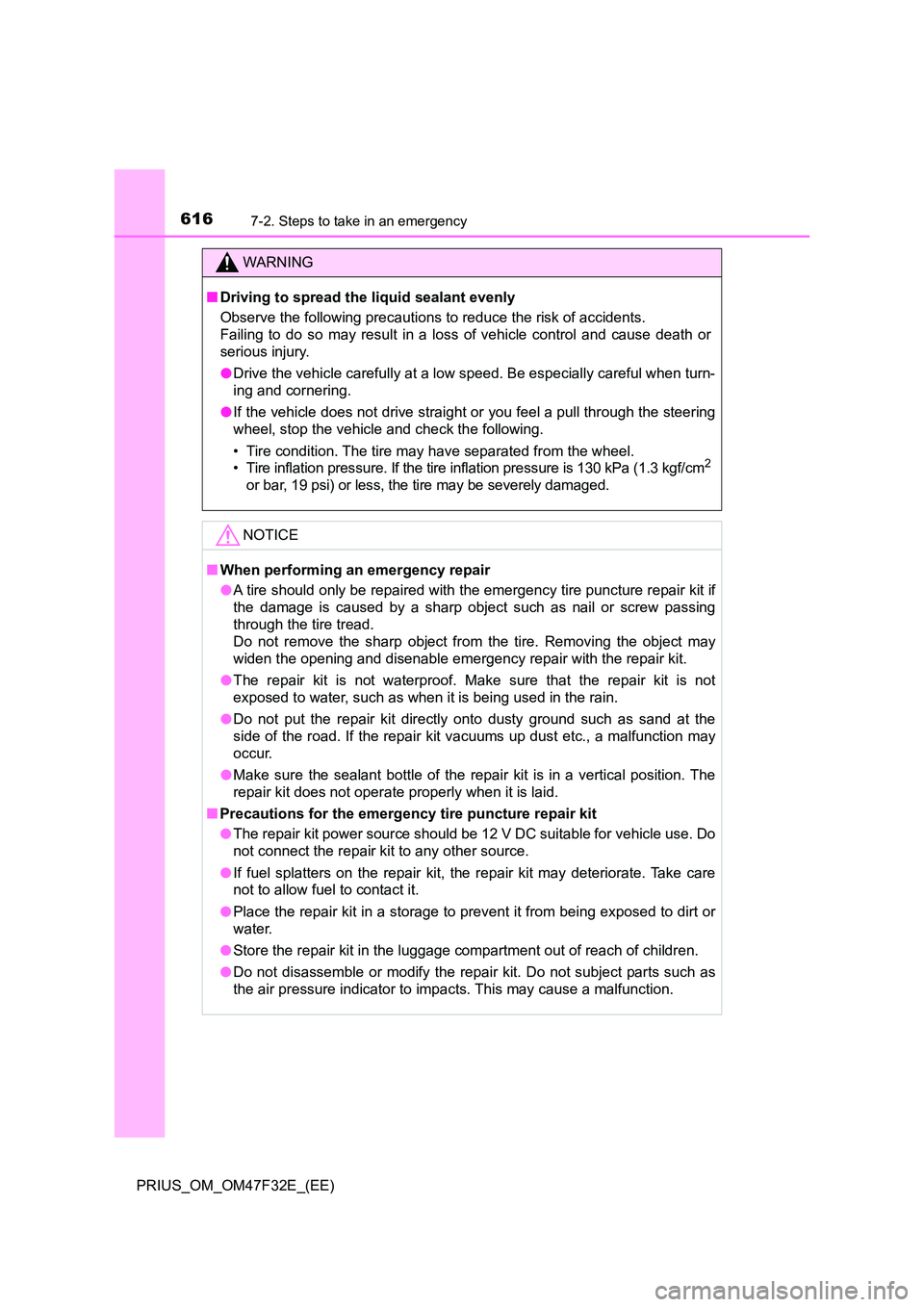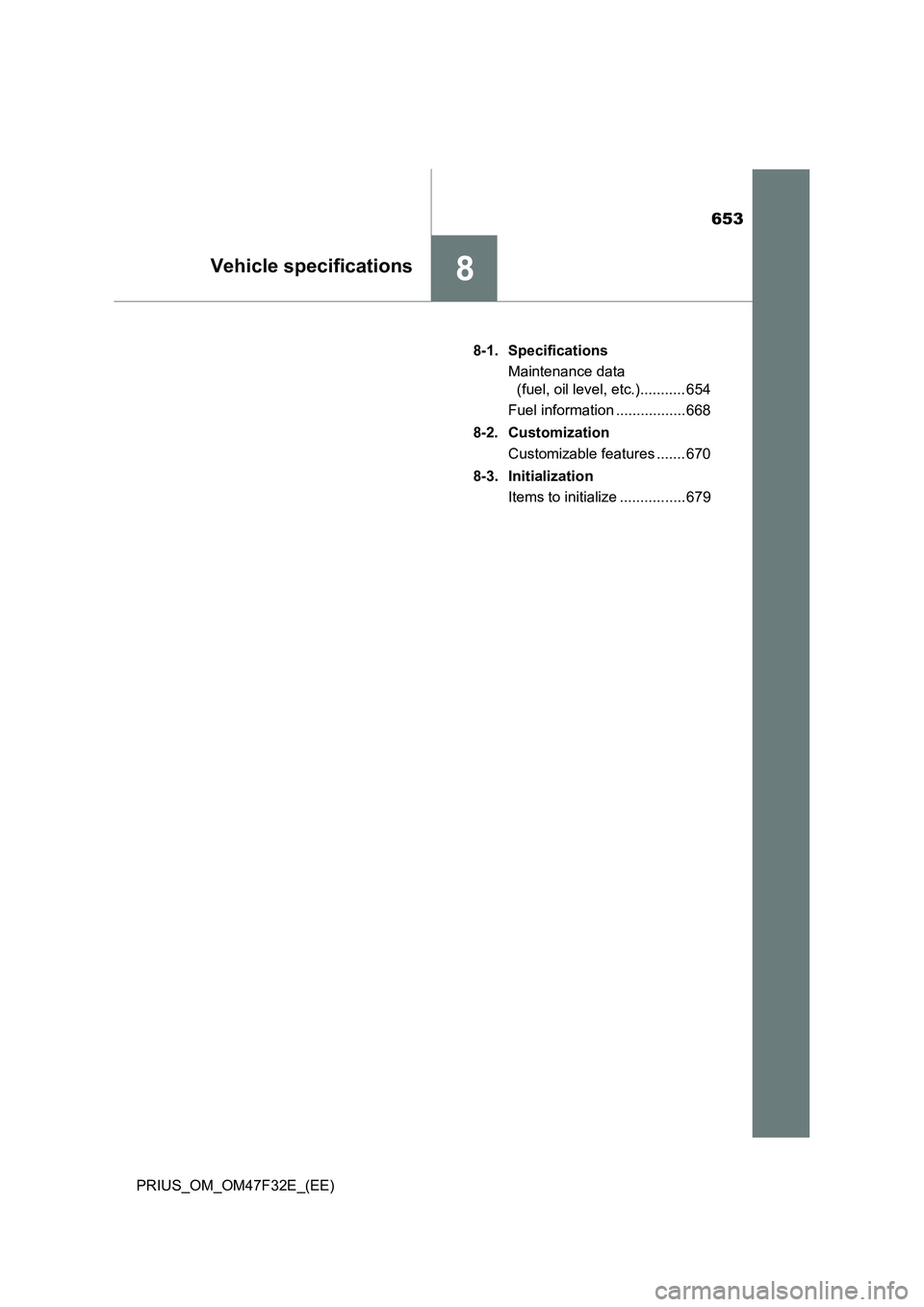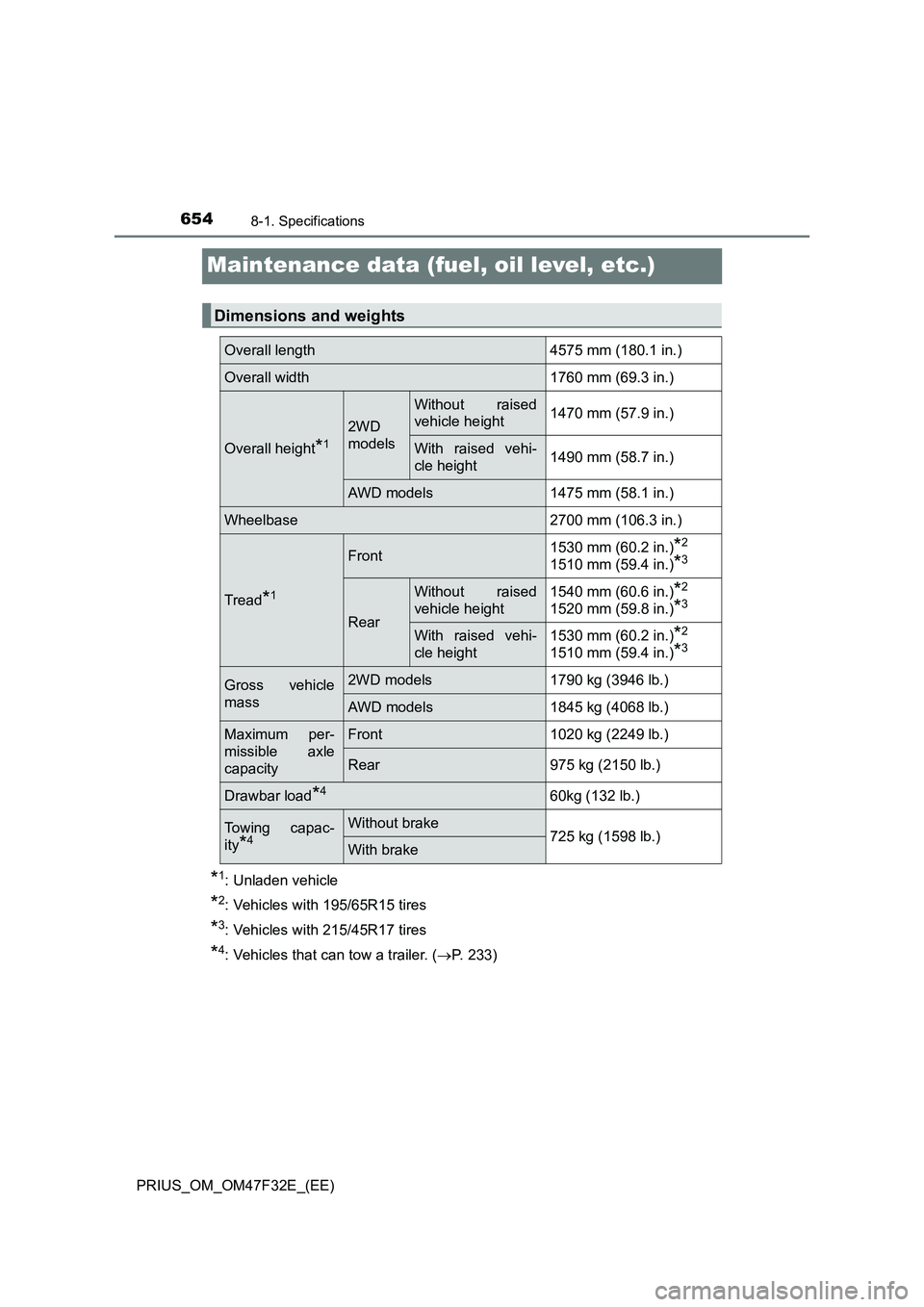2023 TOYOTA PRIUS fuel
[x] Cancel search: fuelPage 547 of 770

5456-3. Do-it-yourself maintenance
PRIUS_OM_OM47F32E_(EE)
6
Maintenance and care
Cleaning the hybrid batter y (traction bat-
ter y) air intake vent and filter
Remove the dust from the air
intake vent with a vacuum
cleaner, etc.
Make sure to only use a vacuum to
suck out dust and clogs. Attempt-
ing to blow out dust and clogs
using an airgun, etc. may push it
into the air intake vent. (P. 549)
If dust and clogs cannot be completely removed with the air intake
vent cover installed, remove the cover and clean the filter.
Turn the power switch off.
Using a Phillips screwdriver,
remove the clip.
To prevent the fuel economy from being affected, visually
inspect the hybrid battery (traction battery) air intake vent peri-
odically for dust and clogs. If it is dusty or clogged or if “Mainte-
nance Required for Traction Battery Cooling Parts See Owner's
Manual” is shown on the multi-information display, clean the air
intake vent using the following procedures:
Cleaning the air intake vent
If dust and clogs cannot be completely removed
1
2
Page 550 of 770

5486-3. Do-it-yourself maintenance
PRIUS_OM_OM47F32E_(EE)
■Scheduled maintenance of the air intake vent is necessary when
In some situations such as when the vehicle is used frequently or in heavy
traffic or dusty areas, the air intake vent may need to be cleaned more regu-
larly. For details, refer to the “Toyota Service Booklet” or “Toyota Warranty
Booklet”.
■ Cleaning the air intake vent
● Dust in the air intake vent may interfere with the cooling of the hybrid battery
(traction battery). If charging/dischargi ng of the hybrid battery (traction bat-
tery) becomes limited, the distance that the vehicle can be driven using the
electric motor (traction motor) may be reduced and the fuel economy may
be reduced. Inspect and clean the air intake vent periodically.
● Improper handling of the air intake vent cover and filter may result in dam-
age to them. If you have any concerns about cleaning the filter, contact any
authorized Toyota retailer or Toyota authorized repairer, or any reliable
repairer.
■ If “Maintenance Required for Traction Battery Cooling Parts See Owner's
Manual” is shown on the multi-information display
● If this warning message is shown on the multi-information display, remove
the air intake vent cover and clean the filter. ( P. 545)
● After cleaning the air intake vent, start the hybrid system and check that the
warning message is no longer shown.
It may take approximately 20 minutes after the hybrid system is started until
the warning message disappears. If the warning message does not disap-
pear, have the vehicle inspected by any authorized Toyota retailer or Toyota
authorized repairer, or any reliable repairer.
WARNING
■ When cleaning the air intake vent
● Do not use water or other liquids to clean the air intake vent. If water is
applied to the hybrid battery (traction battery) or other components, a mal-
function or fire may occur.
● Before cleaning the air intake vent, make sure to turn the power switch off
to stop the hybrid system.
■ When removing the air intake vent cover
Do not touch the service plug located near the air intake vent. ( P. 87)
Page 585 of 770

5837-2. Steps to take in an emergency
PRIUS_OM_OM47F32E_(EE)
7
When trouble arises
High coolant temperature warning light
(vehicles without exhaust heat recirculator system)
Indicates that the engine coolant temperature is too high
Changes from a flashing to a solid light when the engine
coolant temperature increases
Immediately stop the vehicle in a safe place.
( P. 645)
High coolant temperature warning light
(vehicles with exhaust h eat recirculator system)
• When the light flashes:
Indicates that the engine coolant temperature is too high
The light changes from a flashing to a solid light when
the temperature further increases
Immediately stop the vehicle in a safe place.
( P. 645)
• When the light comes on without flashing:
Indicates a malfunction in the exhaust heat recirculator
system
Have the vehicle inspected by any authorized Toyota
retailer or Toyota authorized repairer, or any reliable
repairer immediately.
(Flashes) (If equipped)
PKSB OFF indicator
Indicates a malfunction in the Parking Support Brake func-
tion
Have the vehicle inspected by any authorized Toyota
retailer or Toyota authorized repairer, or any reliable
repairer.
The warning light will operate as follows, even when the
system is not malfunctioning:
• The light will come on when the Parking Support Brake
function is turned off ( P. 396)
• The light will come on when the Parking Support Brake
function is operating ( P. 400)
• The light will flash when the system cannot temporarily
be used ( P. 402)
Open door warning light (warning buzzer)*3
Indicates that a door is not fully closed
Check that all the doors are closed.
Low fuel level warning light
Indicates that remaining fuel is approximately 6.4 L
(1.7 gal., 1.4 Imp.gal.) or less
Refuel the vehicle.
Warning lightWarning light/Details/Actions
Page 588 of 770

5867-2. Steps to take in an emergency
PRIUS_OM_OM47F32E_(EE)
*5: Rear passengers’ seat belt warning buzzer:
The rear passengers’ seat belt warning buzzer sounds to alert the rear
passenger that his or her seat belt is not fastened. If the seat belt is unfas-
tened, the buzzer sounds intermittently for a certain period of time, after
the seat belt is fastened and unfastened and the vehicle reaches a certain
speed.
*6: This symbol is displayed on the multi-information display.
■ Front passenger detection sensor, seat belt reminder and warning
buzzer
● If luggage is placed on the front passenger seat, the front passenger detec-
tion sensor may cause the warning light to flash and the warning buzzer to
sound even if a passenger is not sitting in the seat.
● If a cushion is placed on the seat, the sensor may not detect a passenger,
and the warning light may not operate properly.
■ Electric power steering system warning light (warning buzzer)
When the 12-volt battery charge becomes insufficient or the voltage tempo-
rarily drops, the electric power steering system warning light may come on
and the warning buzzer may sound.
■ If the malfunction indicator lamp comes on while driving
For some models, the malfunction indicator lamp will come on if the fuel tank
becomes completely empty. If the fuel tank is empty, refuel the vehicle imme-
diately. The malfunction indicator lamp will go off after several trips.
If the malfunction indicator lamp does not go off, contact any authorized
Toyota retailer or Toyota authorized repai rer, or any reliable repairer as soon
as possible.
■ When the tire pressure warning light comes on (if equipped)
Inspect the appearance of the tire to check that the tire is not punctured.
If the tire is punctured: P. 598, 618
If the tire is not punctured:
Carry out the following procedure after the tire temperature has lowered suffi-
ciently.
● Check the tire inflation pressure and adjust to the appropriate level.
● If the warning light does not go out even after several minutes, check that
the tire inflation pressure is at the specified level and carry out initialization.
( P. 531)
The warning light may come on again if the above operations are conducted
without first allowing the tire temperature to lower sufficiently.
Page 618 of 770

6167-2. Steps to take in an emergency
PRIUS_OM_OM47F32E_(EE)
WARNING
■Driving to spread the liquid sealant evenly
Observe the following precautions to reduce the risk of accidents.
Failing to do so may result in a loss of vehicle control and cause death or
serious injury.
● Drive the vehicle carefully at a low speed. Be especially careful when turn-
ing and cornering.
● If the vehicle does not drive straight or you feel a pull through the steering
wheel, stop the vehicle and check the following.
• Tire condition. The tire may have separated from the wheel.
• Tire inflation pressure. If the tire inflation pressure is 130 kPa (1.3 kgf/cm2
or bar, 19 psi) or less, the tire may be severely damaged.
NOTICE
■ When performing an emergency repair
● A tire should only be repaired with the emergency tire puncture repair kit if
the damage is caused by a sharp object such as nail or screw passing
through the tire tread.
Do not remove the sharp object from the tire. Removing the object may
widen the opening and disenable emergenc y repair with the repair kit.
● The repair kit is not waterproof. Make sure that the repair kit is not
exposed to water, such as when it is being used in the rain.
● Do not put the repair kit directly onto dusty ground such as sand at the
side of the road. If the repair kit vacuums up dust etc., a malfunction may
occur.
● Make sure the sealant bottle of the repair kit is in a vertical position. The
repair kit does not operate properly when it is laid.
■ Precautions for the emergency tire puncture repair kit
● The repair kit power source should be 12 V DC suitable for vehicle use. Do
not connect the repair kit to any other source.
● If fuel splatters on the repair kit, the repair kit may deteriorate. Take care
not to allow fuel to contact it.
● Place the repair kit in a storage to prevent it from being exposed to dirt or
water.
● Store the repair kit in the luggage compartment out of reach of children.
● Do not disassemble or modify the repair kit. Do not subject parts such as
the air pressure indicator to impacts. This may cause a malfunction.
Page 636 of 770

6347-2. Steps to take in an emergency
PRIUS_OM_OM47F32E_(EE)
If the hybrid system will not star t
One of the following may be the cause of the problem:
● The electronic key may not be functioning properly.* (P. 636)
● There may not be sufficient fuel in the vehicle’s tank.
Refuel the vehicle. ( P. 8 6 )
● There may be a malfunction in the immobilizer system.* (P. 9 1 )
● There may be a malfunction in the shift control system.*
( P. 247, 597)
● The hybrid system may be malfunctioning due to an electrical prob-
lem such as electronic key battery depletion or a blown fuse. How-
ever, depending on the type of malfunction, an interim measure is
available to start the hybrid system. ( P. 635)
*: It may not be possible to shift the shift position other than P.
One of the following may be the cause of the problem:
● The 12-volt battery may be discharged. (P. 639)
● The 12-volt battery terminal connections may be loose or corroded.
( P. 521)
Reasons for the hybrid system not starting vary depending on
the situation. Check the following and perform the appropriate
procedure:
The hybrid system will not start even though the correct starting
procedure is being followed. ( P. 244)
The interior lights and headlights are dim, or the horn does not
sound or sounds at a low volume.
Page 655 of 770

653
8Vehicle specifications
PRIUS_OM_OM47F32E_(EE)8-1. Specifications
Maintenance data
(fuel, oil level, etc.)........... 654
Fuel information ................. 668
8-2. Customization
Customizable features ....... 670
8-3. Initialization
Items to initialize ................ 679
Page 656 of 770

6548-1. Specifications
PRIUS_OM_OM47F32E_(EE)
Maintenance data (fuel, oil level, etc.)
*1: Unladen vehicle
*2: Vehicles with 195/65R15 tires
*3: Vehicles with 215/45R17 tires
*4: Vehicles that can tow a trailer. (P. 233)
Dimensions and weights
Overall length4575 mm (180.1 in.)
Overall width1760 mm (69.3 in.)
Overall height*1
2WD
models
Without raised
vehicle height1470 mm (57.9 in.)
With raised vehi-
cle height1490 mm (58.7 in.)
AWD models1475 mm (58.1 in.)
Wheelbase2700 mm (106.3 in.)
Tread*1
Front1530 mm (60.2 in.)*2
1510 mm (59.4 in.)*3
Rear
Without raised
vehicle height1540 mm (60.6 in.)*2
1520 mm (59.8 in.)*3
With raised vehi-
cle height1530 mm (60.2 in.)*2
1510 mm (59.4 in.)*3
Gross vehicle
mass2WD models1790 kg (3946 lb.)
AWD models1845 kg (4068 lb.)
Maximum per-
missible axle
capacityFront1020 kg (2249 lb.)
Rear975 kg (2150 lb.)
Drawbar load*460kg (132 lb.)
Towing capac-
ity
*4
Without brake725 kg (1598 lb.)With brake